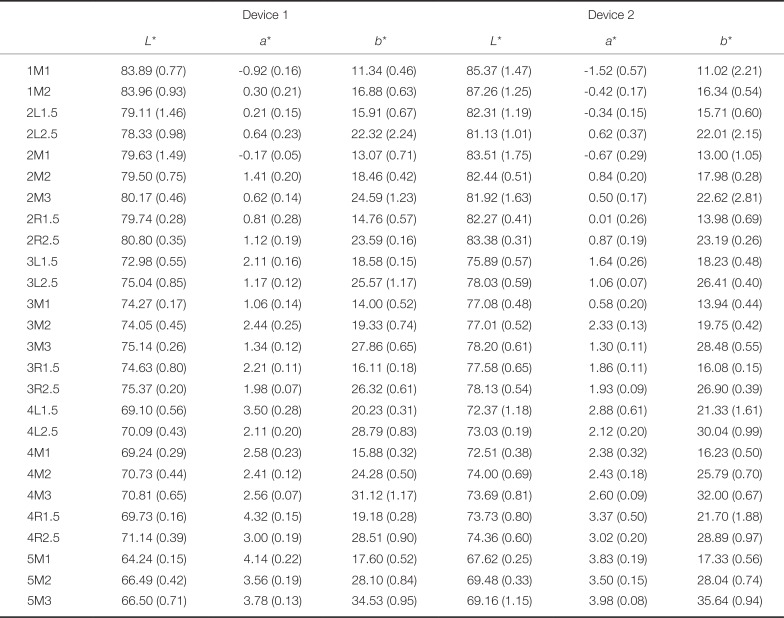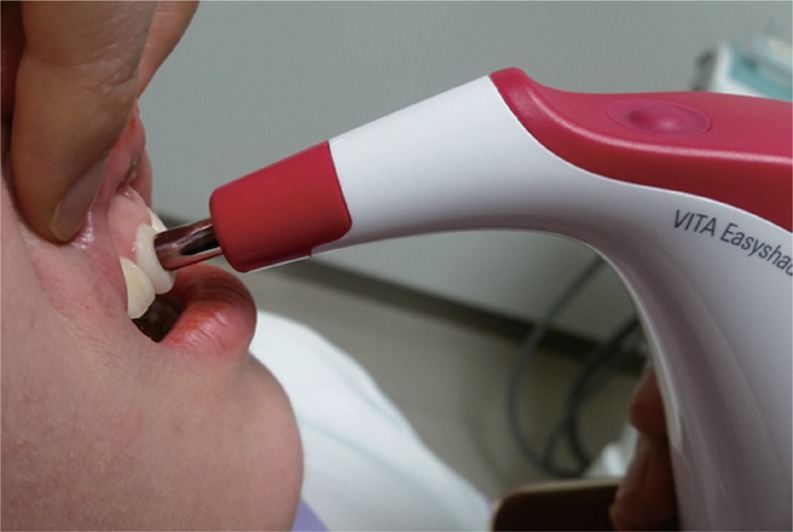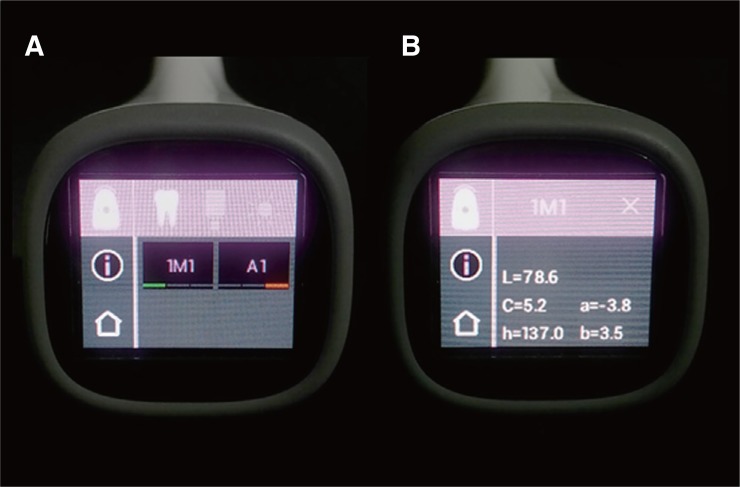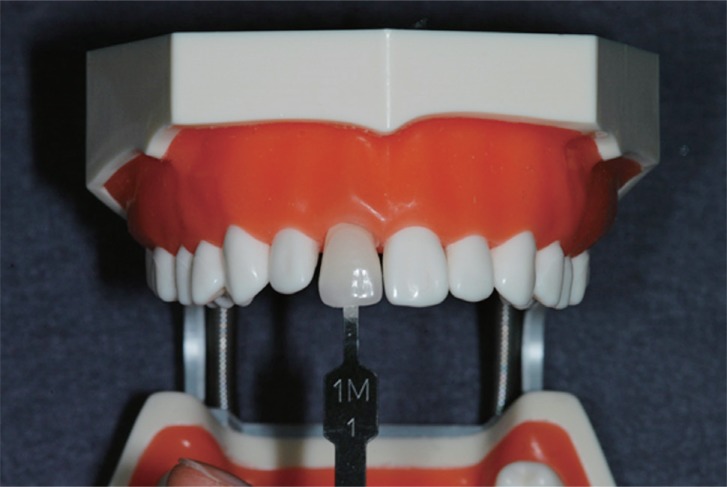1. Jahangiri L, Reinhardt SB, Mehra RV, Matheson PB. Relationship between tooth shade value and skin color: an observational study. J Prosthet Dent. 2002; 87:149–152. PMID:
11854669.

2. Brewer JD, Wee A, Seghi R. Advances in color matching. Dent Clin North Am. 2004; 48:341–358.

3. Dagg H, O'Connell B, Claffey N, Byrne D, Gorman C. The influence of some different factors on the accuracy of shade selection. J Oral Rehabil. 2004; 31:900–904. PMID:
15369473.

4. Ragain JC Jr, Johnston WM. Minimum color differences for discriminating mismatch between composite and tooth color. J Esthet Restor Dent. 2001; 13:41–48. PMID:
11831308.

5. Paul SJ, Peter A, Rodoni L, Pietrobon N. Conventional visual vs spectrophotometric shade taking for porcelain-fused-tometal crowns: a clinical comparison. Int J Periodontics Restorative Dent. 2004; 24:222–231. PMID:
15227770.

7. Kim-Pusateri S, Brewer JD, Dunford RG, Wee AG. In vitro model to evaluate reliability and accuracy of a dental shadematching instrument. J Prosthet Dent. 2007; 98:353–358. PMID:
18021823.

8. Lagouvardos PE, Fougia AG, Diamantopoulou SA, Polyzois GL. Repeatability and interdevice reliability of two portable color selection devices in matching and measuring tooth color. J Prosthet Dent. 2009; 101:40–45. PMID:
19105990.

9. Lehmann KM, Igiel C, Schmidtmann I, Scheller H. Four color-measuring devices compared with a spectrophotometric reference system. J Dent. 2010; 38:e65–e70. PMID:
20659526.

10. Lehmann KM, Devigus A, Igiel C, Wentaschek S, Azar MS, Scheller H. Repeatability of color-measuring devices. Eur J Esthet Dent. 2011; 6:428–435. PMID:
22238725.
11. Sarafianou A, Kamposiora P, Papavasiliou G, Goula H. Matching repeatability and interdevice agreement of 2 intraoral spectrophotometers. J Prosthet Dent. 2012; 107:178–185. PMID:
22385694.

12. Weyhrauch M, Igiel C, Pabst AM, Wentaschek S, Scheller H, Lehmann KM. Interdevice agreement of eight equivalent dental color measurement devices. Clin Oral Investig. 2015; 19:2309–2318.

13. Tsiliagkou A, Diamantopoulou S, Papazoglou E, Kakaboura A. Evaluation of reliability and validity of three dental colormatching devices. Int J Esthet Dent. 2016; 11:110–124. PMID:
26835527.
14. Da Silva JD, Park SE, Weber HP, Ishikawa-Nagai S. Clinical performance of a newly developed spectrophotometric system on tooth color reproduction. J Prosthet Dent. 2008; 99:361–368. PMID:
18456047.

15. Zenthöfer A, Cabrera T, Corcodel N, Rammelsberg P, Hassel AJ. Comparison of the Easyshade Compact and Advance in vitro and in vivo. Clin Oral Investig. 2014; 18:1473–1479.

16. Joiner A. Tooth colour: a review of the literature. J Dent. 2004; 32:3–12.

17. Yuan K, Sun X, Wang F, Wang H, Chen JH. In vitro and in vivo evaluations of three computer-aided shade matching instruments. Oper Dent. 2012; 37:219–227. PMID:
22313274.

18. van der Burgt TP, ten Bosch JJ, Borsboom PC, Kortsmit WJ. A comparison of new and conventional methods for quantification of tooth color. J Prosthet Dent. 1990; 63:155–162. PMID:
2304021.

19. Karaagaclioglu L, Terzioglu H, Yilmaz B, Yurdukoru B. In vivo and in vitro assessment of an intraoral dental colorimeter. J Prosthodont. 2010; 19:279–285. PMID:
20210860.

20. Knezović D, Zlatarić D, Illeš IŽ, Alajbeg M, Žagar . In vivo and in vitro evaluations of repeatability and accuracy of VITA easyshade® advance 4.0 dental shade-matching device. Acta Stomatol Croat. 2015; 49:112–118. PMID:
27688393.

21. Commission Internationale de l'Eclairage (CIE). Colorimetry. Technical Report CIE Publication No.15:2004. 3rd ed. Vienna, Austria: Central Bureau of the CIE;2004.
22. Luo MR, Cui G, Rigg B. The development of the CIE 2000 color difference formula: CIEDE2000. Color Res Appl. 2001; 26:340–350.
23. Ghinea R, Pérez MM, Herrera LJ, Rivas MJ, Yebra A, Paravina RD. Color difference thresholds in dental ceramics. J Dent. 2010; 38:e57–e64. PMID:
20670670.

24. Perez Mdel M, Ghinea R, Herrera LJ, Ionescu AM, Pomares H, Pulgar R, Paravina RD. Dental ceramics: a CIEDE2000 acceptability thresholds for lightness, chroma and hue differences. J Dent. 2011; 39:e37–e44.
25. Xu BT, Zhang B, Kang Y, Wang YN, Li Q. Applicability of CIELAB/CIEDE2000 formula in visual color assessments of metal ceramic restorations. J Dent. 2012; 40:e3–e9.

26. Paravina RD, Ghinea R, Herrera LJ, Bona AD, Igiel C, Linninger M, Sakai M, Takahashi H, Tashkandi E, Perez Mdel M. Color difference thresholds in dentistry. J Esthet Restor Dent. 2015; 27:S1–S9. PMID:
25886208.

27. Seghi RR, Johnston WM, O'Brien WJ. Spectrophotometric analysis of color differences between porcelain systems. J Prosthet Dent. 1986; 56:35–40. PMID:
3459879.

28. Yuan JC, Brewer JD, Monaco EA Jr, Davis EL. Defining a natural tooth color space based on a 3-dimensional shade system. J Prosthet Dent. 2007; 98:110–119. PMID:
17692592.

29. Öngül D, Şermet B, Balkaya MC. Visual and instrumental evaluation of color match ability of 2 shade guides on a ceramic system. J Prosthet Dent. 2012; 108:9–14. PMID:
22765984.

30. Hassel AJ, Grossmann AC, Schmitter M, Balke Z, Buzello AM. Interexaminer reliability in clinical measurement of L*C*h* values of anterior teeth using a spectrophotometer. Int J Prosthodont. 2007; 20:79–84. PMID:
17319369.
31. Fani G, Vichi A, Davidson CL. Spectrophotometric and visual shade measurements of human teeth using three shade guides. Am J Dent. 2007; 20:142–146. PMID:
17672253.







 PDF
PDF ePub
ePub Citation
Citation Print
Print









 XML Download
XML Download